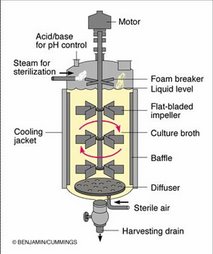A. MUTATION
A certain amount of mutational change in the genome occurs as a natural process, though the probability is small. Exposing a culture of a micro-organism to UV light, ionising radiation or certain chemicals, enhances the rate of occurrence of mutations. But it is a tremendous task for the industrial geneticist to screen the very large number of randomly produced mutants and to select the ones with the desired qualities.
The synthesis of a number of products of cell metabolism is controlled by a 'feed-back inhibition'. When a compound reaches a particular level of accumulation, its synthesis is stopped. Synthesis starts again when the level of the compound falls below the specific level. If a mutant is produced, in which the feedback signalling is suppressed, the product is synthesised continuously. By such a manipulation, a high producing strain of Corynebacterium glutamacium was developed to recover very high quantities of lysine. Such strains that do not produce controlling end products are called auxotrophs.
B. RECOMBINATION
Recombination is defined as any process that brings together genes from different sources.
A strain of Brevibacterium flavum is a high producer of lysine, but is limited by its poor capacity to absorb glucose. Another strain of the bacterium, which is an efficient absorber of glucose but which does not produce lysine, was used to develop a recombinant strain, through protoplast fusion. The new strain utilises high levels of glucose and yields higher levels of lysine.
A gene for the synthesis of phenylalanine was transferred to a chosen strain of Escherichia coli, which was a non-producer, but a good experimental and production tool.
Transformation of a high cephalosporin producing strain of Cephalosporium acremonium with a plasmid containing the gene REXH has significantly increased the titre.
A number of human proteins, such as insulin, human growth hormone, bone growth factor, alpha, beta and gamma interferons, interleukin-2, tumour necrosis factor, tissue plasminogen activator, blood clotting factor VIII, epidermal growth factor, granulocyte colony stimulating factor, erythropoietin, etc., are being produced through recombinant micro-organisms.
C. DNA MANIPULATION
In vitro DNA technology was used to increase the number of copies of a critical pathway gene (operon), as for example the production of threonine in Escherichia coli, at rates 40 to 50 times higher than usual.

